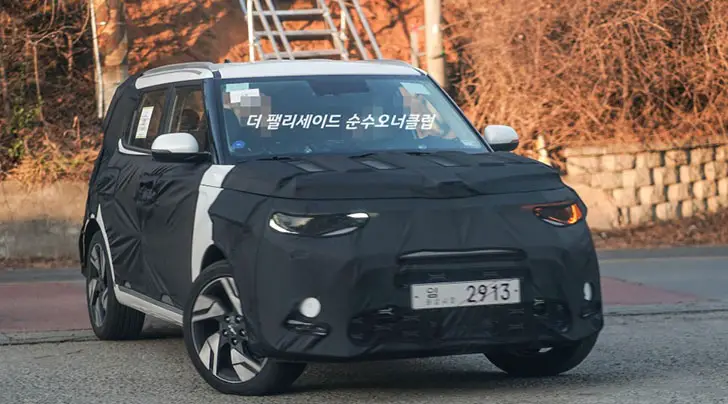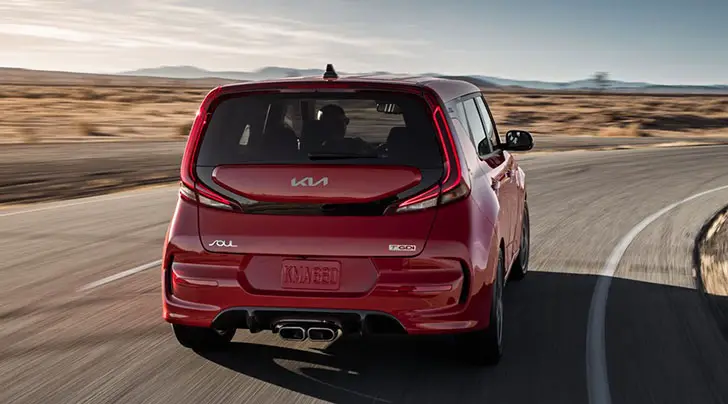Kia has officially unveiled the all-electric Soul EV at the Chicago Auto Show!
This was the first full look at the car that is expected to hit the US showrooms sometime in the third quarter.
The 2015 Kia Soul EV will only be available in limited markets, reserved for those that already have a solid EV infrastructure in place.
That means it will arrive in California, Oregon, New York, New Jersey, and Maryland to begin with.
Expansion is sure to come, but Kia will only do so when the infrastructure required meets the demand for the car. As of yet there is no pricing for the EV.
Soul Electric Vehicle Offers 100 Mile Driving Range
One of the biggest concerns for EV consumers has been the range. The use of a highly energy-dense lithium-ion polymer battery in the EV reduces those concerns.
The 27kWh, air-cooled battery is housed under the floor and is expected to deliver a driving range in the region of 80-100 miles on a full charge.
There were even some scenarios during the internal testing where the car crossed the 100-mile mark.
The battery itself has been engineered to be safe, have a high capacity, and a high level of thermal stability. The capacity is increased thanks to a nickel-cobalt-manganese cathode, while a graphite-based anode helps with durability and weight reduction.
The thermal stability and safety of the car get a boost via a gel electrolyte and a ceramic separator for each cell.
Regenerative Braking Technology
The braking system that has been put in place helps the car capture the kinetic energy of the vehicle, with as much as 12% of the energy captured and fed back to the batter while the Soul EV 2015 is at cruising speed.
There are 4 different regeneration modes to choose from: when the Eco-mode is set to “Off,” there is the choice of “Drive” and “Brake.” With the Eco-mode switched to “On,” the same choices are available, with more power harnessed in this particular mode.
Charging Times Of New Kia Soul EV
It’s incredibly easy to charge the Soul EV, as it can be plugged into any 120v outlet or 240v EV charger.
Two charging ports are standard, including a SAE J1772 port for Level 1 and Level 2 AC, and a CHAdeMo DC fast-charging port (480v).
Both of the ports are discretely located behind a sliding door located in the front grille. The easy access of the ports gives the driver more freedom to charge anywhere, whether at home or on the road.
The time it takes to fully charge an empty battery is dependent on the outlet being used.
While it generally takes a full day to charge on a standard 120v outlet, using the 240v outlet will have it charged in 5 hours.
The charge can get as high as 80% in as little as 33 minutes with a 50kW-output charger.
Soul EV owners have three different options when it comes to the charger they choose, as Kia has partnered with Bosch, Leviton, and AeroVironment. Owners also have the option of heading to the Kia retailer where they purchased their EV in the first place.
Electric Drivetrain Specifications
The EV is a front wheel drive that gets its power from an 81.4 kW, 109-hp electric motor that kicks out a rather impressive 210 lb.-ft. of torque.
Kia engineers found a way to reduce the whine that many electric vehicles tend to have, which they achieved by using multi-layer magnets, which also help improve efficiency.
A single-speed constant-ratio gear delivers power to the front wheels.
The top speed of new Kia Soul EV is expected to be around 90 mph, with acceleration set at 0-60 mph in about 12 seconds.
The positioning of the battery below the floor lends a real feeling of stability that really helps with the ride and handling of the car. In order for the battery to sit where it does, cross bracing has been added that delivers a 5.9% increase in torsional rigidity over the traditional Soul model.
The fact that there is no engine noise, combined with the sound-proofing materials used to build the EV mean a very quiet ride.
The quietness of the ride could be a problem for pedestrians where it not for the addition of a Virtual Engine Sound System that delivers “engine noise” while the car is in reverse or being operated at speeds below 12 mph.
The fact that the battery is not intrusive means that the interior is roomier than you might expect.
The flat design of the battery and its placement beneath the floor results in a slight 3.1-inch leg room differential in back when compared to the traditional Soul.
That said, it is still much roomier than any other EV car currently on the market.
Passengers in back will still have the same shoulder and hip room that they would have in the standard gas-powered Soul, meaning that this electric car is the most spacious in the segment.
There is a slight reduction in rear cargo space with the placement of the battery and cooling fan.
All told, the cargo space has been reduced by 5.1 cubic feet to a total of 19.1 cubic feet.
2015 Soul EV Styling Changes
The same great exterior design is carried over to the EV, including elements such as the “floating” roof to the greenhouse that make you imagine the car is sporting a pair of wraparound sunglasses.
When the car is initially released, it will come in only three different exterior color options: Pearl White with Electronic Blue roof, Caribbean Blue lower body with Clear White roof, and Bright Silver with Clear White roof.
The 2-tone paint scheme was pulled from the Track’ster concept and will be made exclusive to the EV.
A larger grill is featured on the front fascia to help house the charging ports. Other changes to the exterior include color accent trims on the front and rear fascias, as well as LED tail lights and positioning lamps, and projector headlights.
The Soul EV also gets cool new “Eco Electric” badges, as well as a set of 16-inch alloy wheels that come with Super Low Rolling Resistance tires that deliver 10% less resistance than the traditional low rolling tires, all of which adds up to improved range.
One of the critically acclaimed aspects of the second generation Soul was the premium interior and reduced levels of NVH, both of which will carry over to the Soul EV. That interior features a circular theme that is truly aesthetically pleasing.
One way that the EV differentiates itself from the gas model is with the use of white accent trim on the center console, door, and instrument panels. The cool touch adds a feeling of modern styling in the cabin.
UL have issued their first ever automotive environmental claim validation to Kia for their use of bio-based materials, with almost 11 pounds of bio-based organic content used in the interior plastic. Among the highlights in this area is the use of BTX-free pain used on the audio system surround, floor console, and vent bezel.
Cellulose and sugar cane are where many of the bio-based plastics are derived from for use in the cabin in a number of different areas. All told, 19 different interior parts of the Soul EV use these types of materials, once again making it a leader in the segment.
As well as the bio-based materials, there are also a number of antibacterial materials used to add a clean finish to the cabin, most notably on the gear selector and some of the instrument controls.
Eco-friendly materials are found in a total of 23 different parts, once again giving the Soul EV the top spot in that category of the electronic vehicle segment.
The interior colors used are a perfect complement to the colors found on the exterior of the car. A pair of different materials will be offered for the seating, with eco-friendly cloth or optional leather the choices. Each of the options come in grey with blue stitching or piping, depending on the material used. The blue stitching carries over to the steering wheel and center console armrest.
The Soul EV comes with an impressive list of standard equipment, including hands free Bluetooth, navigation, Rear Camera Display, cruise control, 6.6kW on-board charger, and an exclusive HVAC system that uses minimal energy to further extend driving range.
It a well-known fact that the AC can use up a great deal of the energy in an electric car, but that is not the case with thee system in the Soul EV.
Four different technologies are used to deliver AC comfort, whilst also minimizing the amount of energy used: an available heat pump, individual ventilation, scheduled ventilation, and air intake control.
The cabin air is heated with a little help from the surplus heat pulled from the electrical systems of the car. Switching to “Driver Only” mode prevents airflow being sent to any other areas of the car, keeping it solely focused on the driver’s seat area.
This reduces the amount of energy required to keep the cabin at a comfortable temperature.
Ventilation can also be scheduled so that the car is either ore-heated or cooled in the passenger compartment while it is plugged in to the charger. By using recirculated cabin air, the amount of energy usage is again reduced.
The Soul EV will be the first in the Kia lineup to make use of Organic Light Emitting Diode (OLED) technology. The OLED technology means that energy consumption is kept low and very little heat is used, which is a great combination for an electric car.
A 3.5-inch OLED screen is the highlight of the instrument cluster, and displays vital information about the health and performance of the battery, including charging time, battery efficiency, ECO driving level, and more.
The screen also displays a 3-stage alert for the State of Charge (SOC), which allows the driver to see how much charge is left and when the car needs to be plugged in for charging.
The UVO eServices system comes free for the first five years of ownership. This system used in the EV goes a little further than the telematics and infotainment information delivers in the gas-powered Soul.
The UVO eServices system is powered by the Verizon network and can be connected to via a smartphone app.
This can be used to get real-time information about the car, as well as delivering navigation and a host of convenience features that have been specifically put together with the Soul EV in mind, which includes the charging status of the car while it is in motion.
The system also provides crucial information about the status of the battery, including how much longer till a charge is required and the distance to the nearest charging station.
Owners that have the app installed can also control the conditions within the cabin remotely, as well as setting up charging times and levels, all of which can be preset.
One of the advantages of presetting the temperature in advance is reducing the amount of energy drawn from the battery once it has been unhooked from the charger. The UVO system will let the driver know how well they are doing in regards of impact on the environment.
New for the Soul EV UVO eServices system is the ability to download apps that can then be found on the 8-inch touch screen navigation system. One of the apps available is Yelp, which is a great tool that allows users to locate dining, shopping, and more in the area.
Another great app available to the Soul electric vehicle owners is iHeartRadio, which allows them to listen to live radio or create their own commercial free stations that play nothing but the music that they love.
Soundhound is another great app that helps the user recognize songs that are already being played, displaying lyrics, cover art, and a ton of other information in the process.
On top of all that, the 2015 Kia Soul EV also comes with a 5-year complimentary subscription to SiriusXM satellite radio and all the incredible music, entertainment, and traffic information that is delivered via the service.



